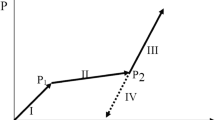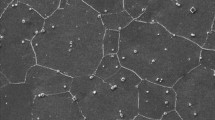Abstract
An experimental-numerical methodology was proposed for the parameter identification of constitutive laws, when applied to hot forging. Industrial presses were directly used to generate the reference experiments for identification. The strain and temperature heterogeneity that appears during on-press compression experiments was taken into account by an FE-based inverse method. Specific experiments were designed for the identification of the heat transfer and friction coefficients. A testing tool was designed and instrumented with displacement sensors and a force cell. This was then used on a hydraulic press and a screw press in order to cover a large range of strain rates. The identified parameter set was validated with respect to specialized plastometers, and a semi-industrial validation forging process. A reasonable accuracy was observed, particularly in realistic forging conditions.
















Similar content being viewed by others
References
Avrami M (1939) Kinetics of Phase Change. I General Theory. J. Chem. Phys. 7(12):1103–1112. https://doi.org/10.1063/1.1750380
Sandström R, Lagneborg R (1975) A model for hot working occurring by recrystallization. Acta Metall. 23(3):387–398. https://doi.org/10.1016/0001-6160(75)90132-7
McQueen HJ (1982) Review of Simulations of Multistage Hot-Forming of Steels. Can. Metall. Q. 21(4):445–460. https://doi.org/10.1179/cmq.1982.21.4.445
Sellars CM, Tegart WJMG (1972) Hot Workability. Int. Metall. Rev. 17(1):1–24. https://doi.org/10.1179/imtlr.1972.17.1.1
Luton MJ, Sellars CM (1969) Dynamic recrystallization in nickel and nickel-iron alloys during high temperature deformation. Acta Metall. 17(8):1033–1043. https://doi.org/10.1016/0001-6160(69)90049-2
Pauskar P, Shivpuri R (1999) Microstructure and Mechanics Interaction in the Modeling of Hot Rolling of Rods. CIRP Ann. 48(1):191–194. https://doi.org/10.1016/S0007-8506(07)63163-1
Hensel A, Spittel T (1978) Kraft und Arbeitsbedarf bildsamer Formgebungsverfahren. Leizig, VEB Deutscher Verlag für Grundstoffindustrie
Jäckel I (1991) Application-oriented modelling of hot yield strength of metallic materials. Steel Res. 62(10):441–446. https://doi.org/10.1002/srin.199100425
Gavrus A, Massoni E, Chenot JL (1998) The analysis of inelastic behaviour formulated as an inverse rheological approach. Meas. Sci. Technol. 9(6):848–863. https://doi.org/10.1088/0957-0233/9/6/002
Bariani PF, Dal Negro T, Bruschi S (2004) Testing and modelling of material response to deformation in bulk metal forming. CIRP Ann.-Manuf. Technol. 53(2):573–595
Lin YC, Chen X-M (2011) A critical review of experimental results and constitutive descriptions for metals and alloys in hot working. Mater. Des. 32(4):1733–1759. https://doi.org/10.1016/j.matdes.2010.11.048
Gelin JC, Ghouati O (1994) An inverse method for determining viscoplastic properties of aluminium alloys. J. Mater. Process. Technol. 45(1–4):435–440. https://doi.org/10.1016/0924-0136(94)90378-6
Gavrus A, Massoni E, Chenot JL (1996) An inverse analysis using a finite element model for identification of rheological parameters. J. Mater. Process. Technol. 60(1–4):447–454. https://doi.org/10.1016/0924-0136(96)02369-2
Kowalski B, Sellars CM, Pietrzyk M (2006) Identification of rheological parameters on the basis of plane strain compression tests on specimens of various initial dimensions. Comput. Mater. Sci. 35(2):92–97. https://doi.org/10.1016/j.commatsci.2005.02.024
Khoddam S, Hodgson PD, Jafari Bahramabadi M (2011) An inverse thermal–mechanical analysis of the hot torsion test for calibrating the constitutive parameters. Mater. Des. 32(4):1903–1909. https://doi.org/10.1016/j.matdes.2010.12.010
Mahnken R, Stein E (1994) The identification of parameters for visco-plastic models via finite-element methods and gradient methods. Model. Simul. Mater. Sci. Eng. 2(3A):597–616. https://doi.org/10.1088/0965-0393/2/3A/013
Andrade-Campos A, Thuillier S, Pilvin P, Teixeira-Dias F (2007) On the determination of material parameters for internal variable thermoelastic–viscoplastic constitutive models. Int. J. Plast. 23(8):1349–1379. https://doi.org/10.1016/j.ijplas.2006.09.002
de-Carvalho R, Valente RAF, Andrade-Campos A (2011) Optimization strategies for non-linear material parameters identification in metal forming problems. Comput. Struct. 89(1–2):246–255. https://doi.org/10.1016/j.compstruc.2010.10.002
Marie S, Ducloux R, Lasne P, Barlier J, Fourment L (2014) Inverse Analysis of Forming Processes based on FORGE environment, in Key Engineering Materials, 611, 1494–1502, Accessed: Apr. 25, 2017. [Online]. Available: http://www.scientific.net/KEM.611-612.1494
Pöhlandt K (1989) Materials Testing for the Metal Forming Industry. Berlin, Heidelberg: Springer Berlin Heidelberg
Gavrus A, Francillette H, Pham DT (2012) An optimal forward extrusion device proposed for numerical and experimental analysis of materials tribological properties corresponding to bulk forming processes. Tribol. Int. 47:105–121. https://doi.org/10.1016/j.triboint.2011.10.013
Diot S, Guines D, Gavrus A, Ragneau E (2009) Minimization of Friction Influence on the Evaluation of Rheological Parameters From Compression Test: Application to a Forging Steel Behavior Identification. J. Eng. Mater. Technol. 131(1):011001. https://doi.org/10.1115/1.3026543
Hor A, Morel F, Lebrun J-L, Germain G (2013) Modelling, identification and application of phenomenological constitutive laws over a large strain rate and temperature range. Mech. Mater. 64:91–110. https://doi.org/10.1016/j.mechmat.2013.05.002
Pietrzyk M, Jedrzejewski J (2001) Identification of parameters in the history dependent constitutive model for steels. CIRP Ann.-Manuf. Technol. 50(1):161–164
Szeliga D, Gawad J, Pietrzyk M (2006) Inverse analysis for identification of rheological and friction models in metal forming. Comput. Methods Appl. Mech. Eng. 195(48–49):6778–6798. https://doi.org/10.1016/j.cma.2005.03.015
Sztangret ł, Szeliga D, Kusiak J, Pietrzyk M (2012) Application of inverse analysis with metamodelling for identification of metal flow stress. Can. Metall. Q. 51(4):440–446. https://doi.org/10.1179/1879139512Y.0000000035
Hor A, Morel F, Lebrun J-L, Germain G (2013) An experimental investigation of the behaviour of steels over large temperature and strain rate ranges. Int. J. Mech. Sci. 67:108–122. https://doi.org/10.1016/j.ijmecsci.2013.01.003
Zhang C, Bellet M, Bobadilla M, Shen H, Liu B (2010) A Coupled Electrical–Thermal–Mechanical Modeling of Gleeble Tensile Tests for Ultra-High-Strength (UHS) Steel at a High Temperature. Metall. Mater. Trans. A 41(9):2304–2317. https://doi.org/10.1007/s11661-010-0310-7
Pidvysotskyy V, Łapczyński Z (2018) Characterization of a steel grade on Gleeble simulator, Instytut metalurgii Zelaza, Poland, technical report B0–1613
Durand C, Bigot R, Baudouin C (2018) Contribution to characterization of metal forming machines: application to screw presses. Procedia Manuf. 15:1024–1032. https://doi.org/10.1016/j.promfg.2018.07.391
Diot S, Guines D, Gavrus A, Ragneau E (2007) Two-step procedure for identification of metal behavior from dynamic compression tests. Int. J. Impact Eng. 34(7):1163–1184. https://doi.org/10.1016/j.ijimpeng.2006.07.003
Wang J, Langlois L, Rafiq M, Bigot R, Lu H (2014) Study of the hot forging of weld cladded work pieces using upsetting tests. J. Mater. Process. Technol. 214(2):365–379. https://doi.org/10.1016/j.jmatprotec.2013.09.009
Venet G, Balan T, Baudouin C, Bigot R (2018) Direct usage of the wire drawing process for large strain parameter identification. Int. J. Mater. Form. https://doi.org/10.1007/s12289-018-01458-z
Emmerich M, Giotis A, Özdemir M, Bäck T, Giannakoglou K (2002) Metamodel—Assisted Evolution Strategies. In: Guervós JJM, Adamidis P, Beyer H-G, Schwefel H-P, Fernández-Villacañas J-L (eds) Parallel Problem Solving from Nature — PPSN VII, vol. 2439. Springer Berlin Heidelberg, Berlin, Heidelberg, pp 361–370
Male AT, Cockcroft MG (1964) A Method for the Determination of the Coefficient of Friction of Metals under Conditions of Bulk Plastic Deformation. J Inst Met. 93:38–46
Charpentier PL, Stone BC, Ernst SC, Thomas JF (1986) Characterization and modeling of the high temperature flow behavior of aluminum alloy 2024. Metall. Trans. A 17(12):2227–2237. https://doi.org/10.1007/BF02645920
Lee CH, Altan T (1972) Influence of Flow Stress and Friction Upon Metal Flow in Upset Forging of Rings and Cylinders. J. Eng. Ind. 94(3):775. https://doi.org/10.1115/1.3428250
Saha PK, Wilson WRD (1994) Influence of plastic strain on friction in sheet metal forming. Wear 172(2):167–173. https://doi.org/10.1016/0043-1648(94)90284-4
Acknowledgments
The authors are grateful to Dr. Valeriy Pidvysotskyy and Prof. Roman Kuziak from IMŻ Gliwice (Poland) who performed the Gleeble experiments. The press-shop experimental work was carried out with substantial contributions from Alexandre Fendler, Sébastien Burgun and Stéphane Mathieu (from Arts et Metiers) and Josselin Schumacker (from AMValor). The DIL805 plasto-dilatometer experiments were performed at ABS Centre Métallurgique (ACM), Metz (France).
Funding
The first author received funding from the French Ministry of National Education, Higher Education and Research.
Author information
Authors and Affiliations
Corresponding author
Ethics declarations
Declaration of interest
None.
Additional information
Publisher’s note
Springer Nature remains neutral with regard to jurisdictional claims in published maps and institutional affiliations.
Rights and permissions
About this article
Cite this article
Venet, G., Baudouin, C., Pondaven, C. et al. Parameter identification of 42CrMo4 steel hot forging plastic flow behaviour using industrial upsetting presses and finite element simulations. Int J Mater Form 14, 929–945 (2021). https://doi.org/10.1007/s12289-020-01609-1
Received:
Accepted:
Published:
Issue Date:
DOI: https://doi.org/10.1007/s12289-020-01609-1




